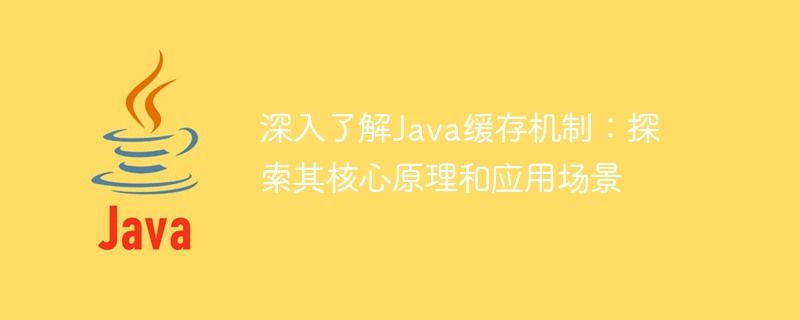
In-depth understanding of Java caching mechanism: explore its core principles and application scenarios
Introduction:
In software development, caching is a common optimization method. Used to improve system performance and response speed. As a widely used programming language, Java provides a rich caching mechanism, and developers can choose appropriate caching solutions according to different scenarios. This article will deeply explore the core principles and application scenarios of Java caching mechanism, and give corresponding code examples.
1. The concept and function of caching
Cache refers to temporarily storing calculation results or data in high-speed memory, thereby accelerating subsequent access and calculation processes. It can avoid repeated calculations or repeated access to the database, significantly improving system performance and response speed.
The role of cache mainly has three aspects:
- Improving performance: Cache can store frequently used data or calculation results and reduce the number of accesses to the underlying storage system (such as disk). Because high-speed memory can read and write much faster than the underlying storage system, it can significantly improve system performance.
- Reduce resource consumption: Caching can reduce the occupation of computing resources (such as CPU) and network resources (such as database connections), and reduce the load pressure on the system.
- Improve reliability: The cache can store backup data, and when the underlying storage system fails, the normal operation of the system can be quickly restored.
2. The core principle of Java cache mechanism
Java provides a variety of cache mechanisms, the more common of which include memory cache, distributed cache and database cache. The core principles of these caching mechanisms are as follows:
- Memory cache
Memory cache stores data in memory to increase read and write speeds. In Java, memory caching can be implemented using data structures such as HashMap and ConcurrentHashMap. The specific steps are as follows:
(1) Check whether the required data exists in the cache, and return directly if it exists;
(2) If the required data does not exist in the cache, obtain the data from the underlying storage system, and Store in the cache;
(3) On the next access, first obtain the data from the cache, and return directly if it exists, otherwise obtain the data from the underlying storage system.
- Distributed cache
Distributed cache stores data in a cluster to improve the scalability and fault tolerance of the system. In Java, open source software such as Redis and Memcached can be used to implement distributed caching. The specific steps are as follows:
(1) The client sends a request to the cache server to query the required data;
(2) The cache server checks whether the required data exists in the cache, and returns directly if it exists;
( 3) If the required data does not exist in the cache, obtain the data from the underlying storage system and store it in the cache;
(4) When querying next time, first check whether the data exists in the cache, and return directly if it exists , otherwise the data will be obtained from the underlying storage system.
- Database cache
Database cache stores hotspot data in memory to speed up database queries and update operations. In Java, you can use ORM frameworks such as MyBatis and Hibernate to implement database caching. The specific steps are as follows:
(1) Store the query results or update operation results in the database cache;
(2) When querying next time, first check whether the required data exists in the cache, and return directly if it exists , otherwise get the data from the database.
3. Application Scenarios of Java Cache Mechanism
Java cache mechanism is suitable for various application scenarios. Here are several common application scenarios:
- Frequently read data
For frequently read data, you can store it in the memory cache to increase the reading speed. For example, in an e-commerce website, the basic information of products (such as product name, price, etc.) is usually frequently read data, which can be stored in the memory cache to reduce the number of accesses to the database.
- Complex or time-consuming calculation results
For complex or time-consuming calculation results, you can store them in the memory cache to reduce calculation time. For example, in a financial system, statistical analysis of a large amount of data may take a long time, and the calculation results can be stored in the memory cache to improve the system's response speed.
- Highly concurrently accessed data
For highly concurrently accessed data, distributed cache can be used to improve the system's concurrent processing capabilities. For example, in a social network application, the user's follower list is a highly concurrently accessed data, which can be stored in a distributed cache to spread the pressure of user requests.
Summary:
The Java caching mechanism is a common performance optimization method that improves system performance and response speed by storing commonly used data or calculation results in high-speed memory. This article deeply explores the core principles and common application scenarios of the Java caching mechanism, and gives corresponding code examples. I hope readers can rationally use the Java caching mechanism in actual development to improve system performance and user experience.
The above is the detailed content of The core principles and application scenarios of Java caching mechanism revealed. For more information, please follow other related articles on the PHP Chinese website!






